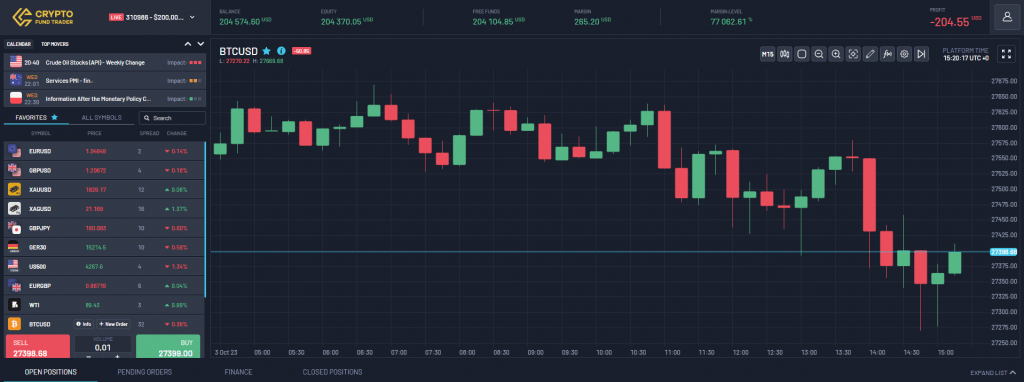
From trading on a crypto exchange to trading with a crypto Prop Firm.
Coming from the traditional world of crypto trading on exchanges, you might find the transition to trading crypto with a prop firm intimidating. In this blog, we will aim to help you make that transition smoother and more enjoyable.
Unlike the usual way of trading crypto on exchanges, when you decide to go down the Prop Firm route, you will have to transition over to trading on a platform that is offered by the broker. Most firms offer a single trading platform to their traders – MetaTrader 5. Although that is the most popular platform in the trading industry with great functionalities, it may seem confusing and intimidating to a crypto trader coming from an exchange trading environment.
That is why here at Crypto Fund Trader, apart from offering MT5, we have also developed our own trading platform with a modern UI that will feel right at home for all of our crypto traders.
You can give it a try with our demo credentials bellow:
https://trading.cryptofundtrader.com/
Email: demo@cryptofundtrader.com
Password: DemoCFT1

Getting familiar with the pre-defined leverage.
Here at Crypto Fund Trader we offer 1:100 leverage for all instruments, including crypto. The leverage on our platforms is pre-defined as 1:100 which leads to a lot of crypto traders, used to trading on exchanges, asking questions like: “How do we adjust the leverage?”or “can we trade with lower leverage?”.
Unlike crypto exchanges, where the user can choose between Cross and Isolated Margin and manually adjust the leverage, trading with a Prop Firm is different.
Here, the accounts are always cross-margin, meaning that all of the balance is used to cover your losses. You don’t need to worry about margin calls, and the leverage not being adjustable. You only need to worry about managing your position exposure and focus on respecting your drawdown levels.
Lots? Volume? How do I enter with Dollars?
Transitioning to trading with a Prop Firm for the first time can leave you with a lot of questions such as the ones above. But do not worry – we are here to help you get familiar with it all!
Entering trades on our platforms is not done in dollars but rather lots. One lot may be equal to one or multiple units of an asset. For crypto, 1 lot = 1 unit (1 coin).
Entering a BTC trade at a price of $25k with the volume of 1 lot would mean that you are entering the trade with a $25k position size.
To convert your dollar position size to lots is very easily done with the following formula:
Position size in dollars / Price of asset at entry = Lot Size
To further clarify this we will give you another example:
In this example we want to enter a Solana trade with $45k in position size at an entry of $18. Using the formula above, the calculation would look like this:
45000 / 18 = 2500 lots; This would mean that in order to enter the trade with your already determined position size of $45k, you need to enter with 2500 lots.
Still not sure how to calculate your position size? No worries – let’s dive a bit deeper to make it clearer for you.
You need to know two things in order to correctly calculate your position size:
– How much you are willing to risk on the trade in dollars
– The percentage from your Entry to your Stop Loss
Once you have those values, the formula to calculate position size would look like this:
Risk (in dollars) / (% from entry to SL / 100) = Position Size in dollars
Again, we will give you an example to make things more clear:
Let’s say we want to risk $20 on a trade and our Stop Loss is 1.5% from our Entry. Using the formula above, the calculation would look like this:
20 / (1.5/100) = $1333 in position size. This means that when we enter with $1333 in size, if our SL (which is 1.5% away from our entry) is triggered, we would lose $20.
Final Notes.
We are hoping that this blog was helpful to our fellow crypto traders that are looking to transition into trading with a prop firm. If you have any further questions, you can also contact our support team (available 24 hours, 7 days a week) via our discord, telegram or live chat.
Article written by Steven A. , member of the CFT support team.